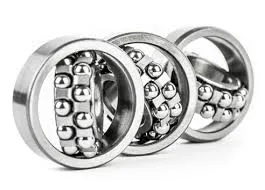
Nov . 25, 2024 05:35 Back to list
Understanding the Function and Benefits of Angular Contact Bearings in Machinery
What is an Angular Contact Bearing?
Angular contact bearings are a specialized type of rolling-element bearing designed to accommodate both axial and radial loads. Unlike standard radial ball bearings, which can only handle radial loads, angular contact bearings allow for more versatility in various applications, making them crucial components in many mechanical systems.
Design and Structure
The configuration of an angular contact bearing features balls that are placed between the inner and outer races at an angle. This angle is significant; it allows the bearing to sustain a higher axial load in one direction while supporting radial loads at the same time. The angle itself, typically ranging from 15 to 40 degrees, establishes the bearing's load capacity and its ability to perform under various operational conditions.
Angular contact bearings are often produced in pairs or sets to improve their load-carrying capability. When arranged in pairs, they can handle loads in both axial directions effectively. They are commonly available in different configurations, including single-row, double-row, and even four-point contact bearings, depending on the specific requirements of the application.
Types of Angular Contact Bearings
There are several different types of angular contact bearings, each suited for various applications. The most common types include
1. Single-Row Angular Contact Bearings These bearings handle axial loads in one direction and provide a high degree of flexibility and performance. They are widely used in spindle applications where precision and high-speed operation are crucial.
2. Double-Row Angular Contact Bearings This type allows for higher load capacity and is better suited for applications where both axial and radial loads are present. They are often found in heavy machinery and automotive applications.
what is an angular contact bearing

3. Four-Point Contact Bearings These bearings facilitate a more versatile load-handling capability by allowing four points of contact between the balls and raceways. They are particularly useful in applications requiring high radial loads, such as in the construction and mining industries.
Applications
Angular contact bearings are used across various industries where machinery must operate under high speed and load conditions. Common applications include
- Aerospace Used in jet engines and landing gear where reliability and performance are critical. - Automotive Found in wheel bearings, steering systems, and transmissions, where they accommodate directional loads. - Industrial Machinery Essential for high-speed spindles in CNC machines, where precision is paramount. - Robotics Utilized in joints and actuators, providing stability and movement in robotic applications.
Advantages
One of the most significant advantages of angular contact bearings is their capability to handle combined loads effectively. The design allows them to maintain accuracy and rigidity, providing enhanced performance over standard bearings. Additionally, they generally offer a compact design, allowing for space-saving installations.
Another advantage is their ability to operate at high speeds, making them an ideal choice for applications requiring rapid movement. They also exhibit low friction, which translates to less energy consumption and prolonged service life.
Conclusion
Angular contact bearings are indispensable components in many mechanical systems, providing reliable performance under challenging conditions. With their unique design and capability to handle both radial and axial loads, they are suited for a wide range of applications across various industries. Understanding the specific types and benefits of angular contact bearings can help engineers and technicians select the right bearing for their needs, ensuring optimal performance and longevity in their machinery. Whether in aerospace, automotive, or industrial applications, these bearings play a crucial role in the efficiency and reliability of modern mechanics.
Latest news
-
Premium Deep Groove Ball Bearings | High Speed & Reliability
NewsAug.29,2025
-
Durable Scaffolding Clamps - Secure & Reliable Tube Connectors
NewsAug.28,2025
-
Common Failures in Thrust Ball Bearings and Solutions
NewsAug.22,2025
-
How Tapered Roller Bearings Can Take Shock Loads
NewsAug.22,2025
-
Angular Bearings in High-Precision Spindles
NewsAug.22,2025
-
The Impact of Misalignment on Cylindrical Roller Bearing Performance
NewsAug.22,2025
